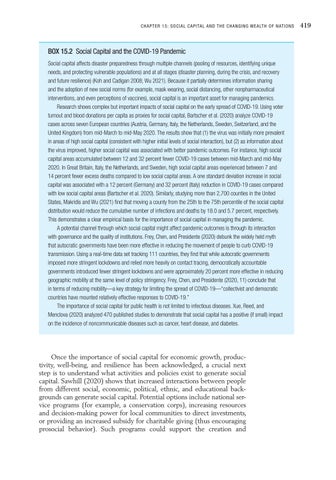CH AP TER 1 5 : SOC IAL C APITAL AND THE C HANGING W EALTH OF NATIONS
BOX 15.2 Social Capital and the COVID-19 Pandemic Social capital affects disaster preparedness through multiple channels (pooling of resources, identifying unique needs, and protecting vulnerable populations) and at all stages (disaster planning, during the crisis, and recovery and future resilience) (Koh and Cadigan 2008; Wu 2021). Because it partially determines information sharing and the adoption of new social norms (for example, mask wearing, social distancing, other nonpharmaceutical interventions, and even perceptions of vaccines), social capital is an important asset for managing pandemics. Research shows complex but important impacts of social capital on the early spread of COVID-19. Using voter turnout and blood donations per capita as proxies for social capital, Bartscher et al. (2020) analyze COVID-19 cases across seven European countries (Austria, Germany, Italy, the Netherlands, Sweden, Switzerland, and the United Kingdom) from mid-March to mid-May 2020. The results show that (1) the virus was initially more prevalent in areas of high social capital (consistent with higher initial levels of social interaction), but (2) as information about the virus improved, higher social capital was associated with better pandemic outcomes. For instance, high social capital areas accumulated between 12 and 32 percent fewer COVID-19 cases between mid-March and mid-May 2020. In Great Britain, Italy, the Netherlands, and Sweden, high social capital areas experienced between 7 and 14 percent fewer excess deaths compared to low social capital areas. A one standard deviation increase in social capital was associated with a 12 percent (Germany) and 32 percent (Italy) reduction in COVID-19 cases compared with low social capital areas (Bartscher et al. 2020). Similarly, studying more than 2,700 counties in the United States, Makridis and Wu (2021) find that moving a county from the 25th to the 75th percentile of the social capital distribution would reduce the cumulative number of infections and deaths by 18.0 and 5.7 percent, respectively. This demonstrates a clear empirical basis for the importance of social capital in managing the pandemic. A potential channel through which social capital might affect pandemic outcomes is through its interaction with governance and the quality of institutions. Frey, Chen, and Presidente (2020) debunk the widely held myth that autocratic governments have been more effective in reducing the movement of people to curb COVID-19 transmission. Using a real-time data set tracking 111 countries, they find that while autocratic governments imposed more stringent lockdowns and relied more heavily on contact tracing, democratically accountable governments introduced fewer stringent lockdowns and were approximately 20 percent more effective in reducing geographic mobility at the same level of policy stringency. Frey, Chen, and Presidente (2020, 11) conclude that in terms of reducing mobility—a key strategy for limiting the spread of COVID-19—“collectivist and democratic countries have mounted relatively effective responses to COVID-19.” The importance of social capital for public health is not limited to infectious diseases. Xue, Reed, and Menclova (2020) analyzed 470 published studies to demonstrate that social capital has a positive (if small) impact on the incidence of noncommunicable diseases such as cancer, heart disease, and diabetes.
Once the importance of social capital for economic growth, productivity, well-being, and resilience has been acknowledged, a crucial next step is to understand what activities and policies exist to generate social capital. Sawhill (2020) shows that increased interactions between people from different social, economic, political, ethnic, and educational backgrounds can generate social capital. Potential options include national service programs (for example, a conservation corps), increasing resources and decision-making power for local communities to direct investments, or providing an increased subsidy for charitable giving (thus encouraging prosocial behavior). Such programs could support the creation and
419


